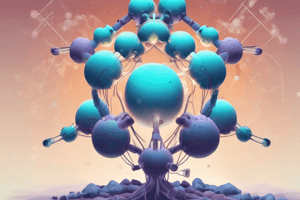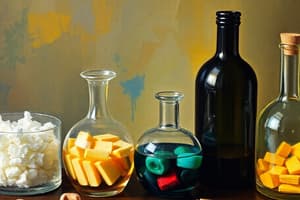Podcast
Questions and Answers
What distinguishes a compound from a mixture?
What distinguishes a compound from a mixture?
- Compounds retain the properties of their constituent elements.
- Compounds are composed of two or more substances that are physically combined.
- Compounds can be separated by physical means.
- Compounds have a fixed ratio of elements. (correct)
Which element classification is characterized by being good conductors of heat and electricity?
Which element classification is characterized by being good conductors of heat and electricity?
- Metalloids
- Noble Gases
- Metals (correct)
- Nonmetals
Which group of elements is known to be very reactive nonmetals?
Which group of elements is known to be very reactive nonmetals?
- Alkaline Earth Metals
- Alkali Metals
- Halogens (correct)
- Noble Gases
What is true about noble gases?
What is true about noble gases?
What happens to the reactivity of alkali metals as you move down the group?
What happens to the reactivity of alkali metals as you move down the group?
How can mixtures typically be separated?
How can mixtures typically be separated?
Which of the following statements about metalloids is correct?
Which of the following statements about metalloids is correct?
Which of the following is an example of a compound?
Which of the following is an example of a compound?
Which statement about nonmetals is true?
Which statement about nonmetals is true?
What is the primary characteristic of alkaline earth metals?
What is the primary characteristic of alkaline earth metals?
Flashcards are hidden until you start studying
Study Notes
Mixtures Vs Compounds
-
Mixtures:
- Composed of two or more substances that are physically combined.
- Components retain their individual properties.
- Can be separated by physical means (e.g., filtration, distillation).
- Example: Air (a mixture of gases), salad (mixed vegetables).
-
Compounds:
- Formed when two or more elements chemically combine in fixed ratios.
- Have distinct properties different from their constituent elements.
- Cannot be separated by physical means; require chemical reactions to break down.
- Example: Water (H₂O), sodium chloride (NaCl).
Element Classification
-
Metals:
- Good conductors of heat and electricity.
- Typically shiny, malleable, and ductile.
- Located on the left side of the periodic table (e.g., iron, gold).
-
Nonmetals:
- Poor conductors of heat and electricity.
- Can be gases, liquids, or brittle solids.
- Located on the right side of the periodic table (e.g., oxygen, sulfur).
-
Metalloids:
- Exhibit properties of both metals and nonmetals.
- Semiconductors; useful in electronics (e.g., silicon, arsenic).
-
Noble Gases:
- Group of nonmetals that are odorless, colorless, and inert.
- Found in Group 18 of the periodic table (e.g., helium, neon).
Reactivity Of Elements
-
Reactivity Trends:
- Metals tend to lose electrons and form positive ions; reactivity increases down a group.
- Nonmetals tend to gain electrons to form negative ions; reactivity increases up a group.
-
Alkali Metals (Group 1):
- Highly reactive, especially with water; reactivity increases down the group (e.g., lithium to cesium).
-
Alkaline Earth Metals (Group 2):
- Reactive but less so than alkali metals; reactivity increases down the group (e.g., magnesium to barium).
-
Halogens (Group 17):
- Very reactive nonmetals; reactivity decreases down the group (e.g., fluorine to iodine).
-
Noble Gases:
- Generally inert, do not readily react due to complete valence electron shells.
-
Factors Affecting Reactivity:
- Atomic size: larger atoms tend to lose electrons more easily.
- Ionization energy: lower ionization energy increases reactivity in metals.
- Electronegativity: higher electronegativity increases reactivity in nonmetals.
Mixtures Vs Compounds
- Mixtures are combinations of two or more substances that are not chemically bonded.
- Components of mixtures maintain their original properties and can be identified separately.
- Different separation techniques like filtration and distillation are effective for mixtures.
- Common examples include air, which consists of a blend of gases, and salad, made up of mixed vegetables.
- Compounds result from the chemical combination of two or more elements in specific ratios.
- Compounds exhibit unique properties that differ from those of their individual elements.
- Chemical reactions are necessary to separate compounds, as physical methods are ineffective.
- Notable examples include water (H₂O) and sodium chloride (NaCl).
Element Classification
- Metals are found on the left side of the periodic table and are characterized by their ability to conduct heat and electricity efficiently.
- They are typically shiny, malleable (can be shaped), and ductile (can be drawn into wires).
- Nonmetals are located on the right side of the periodic table and generally exhibit poor conductivity.
- They can exist in various states: gases (e.g., oxygen), liquids (e.g., bromine), or brittle solids (e.g., sulfur).
- Metalloids possess characteristics of both metals and nonmetals, functioning as semiconductors valuable in electronic applications.
- Prominent metalloids include silicon and arsenic.
- Noble Gases include odorless, colorless, and chemically inert nonmetals, found in Group 18 of the periodic table, examples being helium and neon.
Reactivity Of Elements
- Reactivity Trends indicate that metals often lose electrons to form positive ions, with reactivity increasing down a group.
- Nonmetals typically gain electrons to create negative ions, and their reactivity increases as one moves up a group.
- Alkali Metals (Group 1) are highly reactive, especially with water, with reactivity escalating down the group from lithium to cesium.
- Alkaline Earth Metals (Group 2) are less reactive than alkali metals; their reactivity similarly increases down the group from magnesium to barium.
- Halogens (Group 17) are very reactive nonmetals, but their reactivity decreases down the group, from fluorine to iodine.
- Noble Gases are largely unreactive due to having a complete valence electron shell.
- Key factors affecting element reactivity include atomic size (larger atoms lose electrons more readily), ionization energy (lower energy increases metal reactivity), and electronegativity (higher values boost nonmetals' reactivity).
Studying That Suits You
Use AI to generate personalized quizzes and flashcards to suit your learning preferences.




